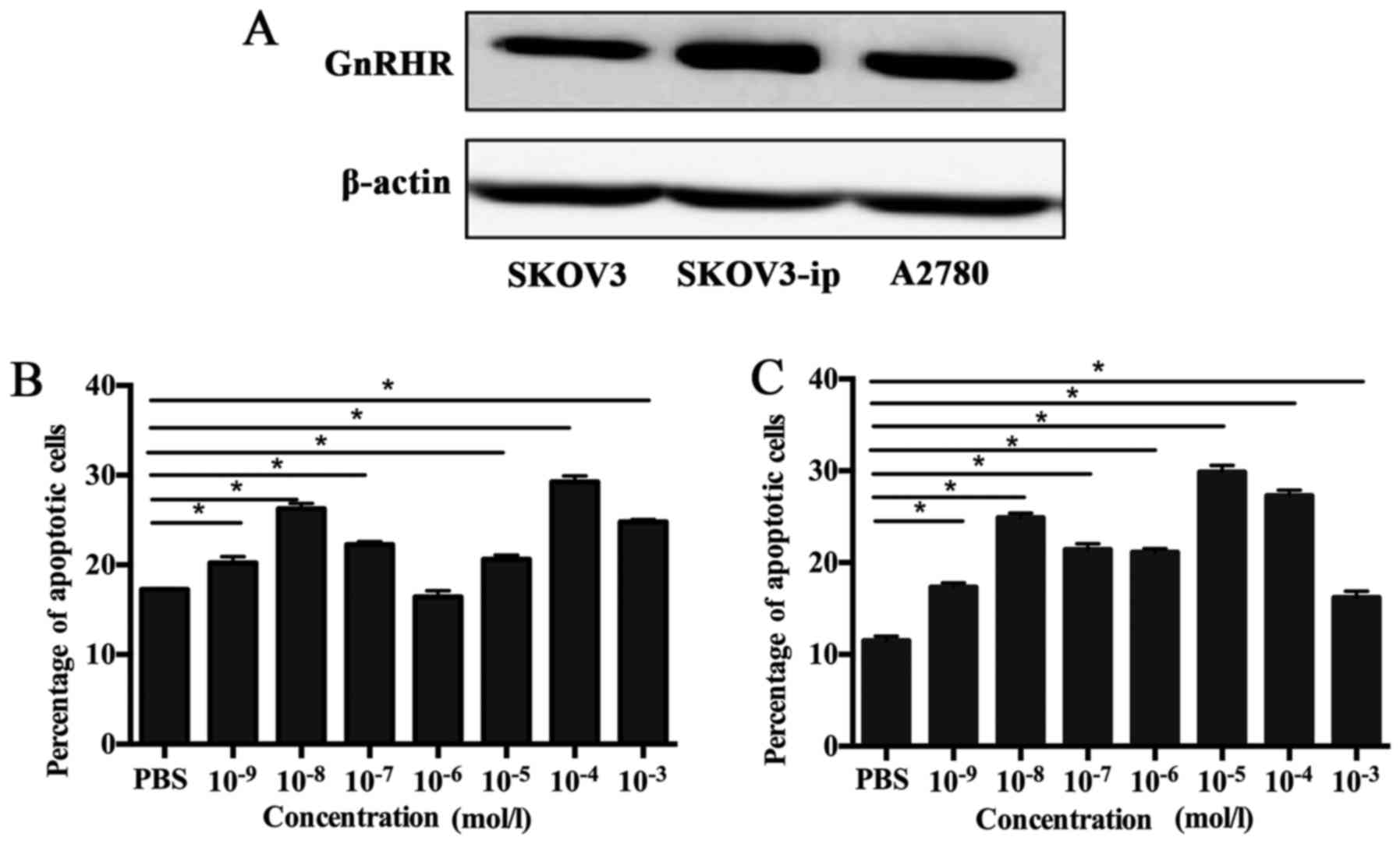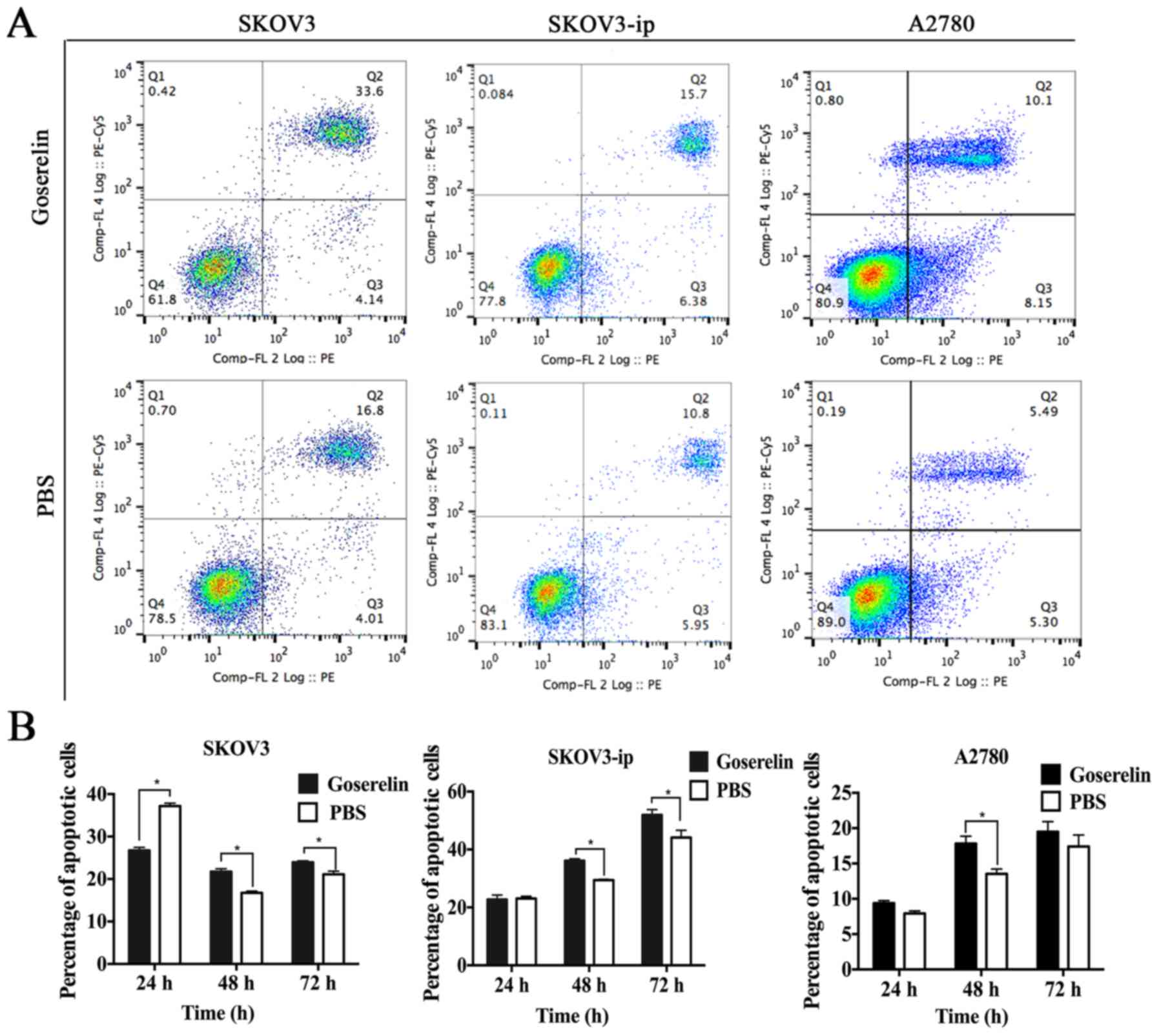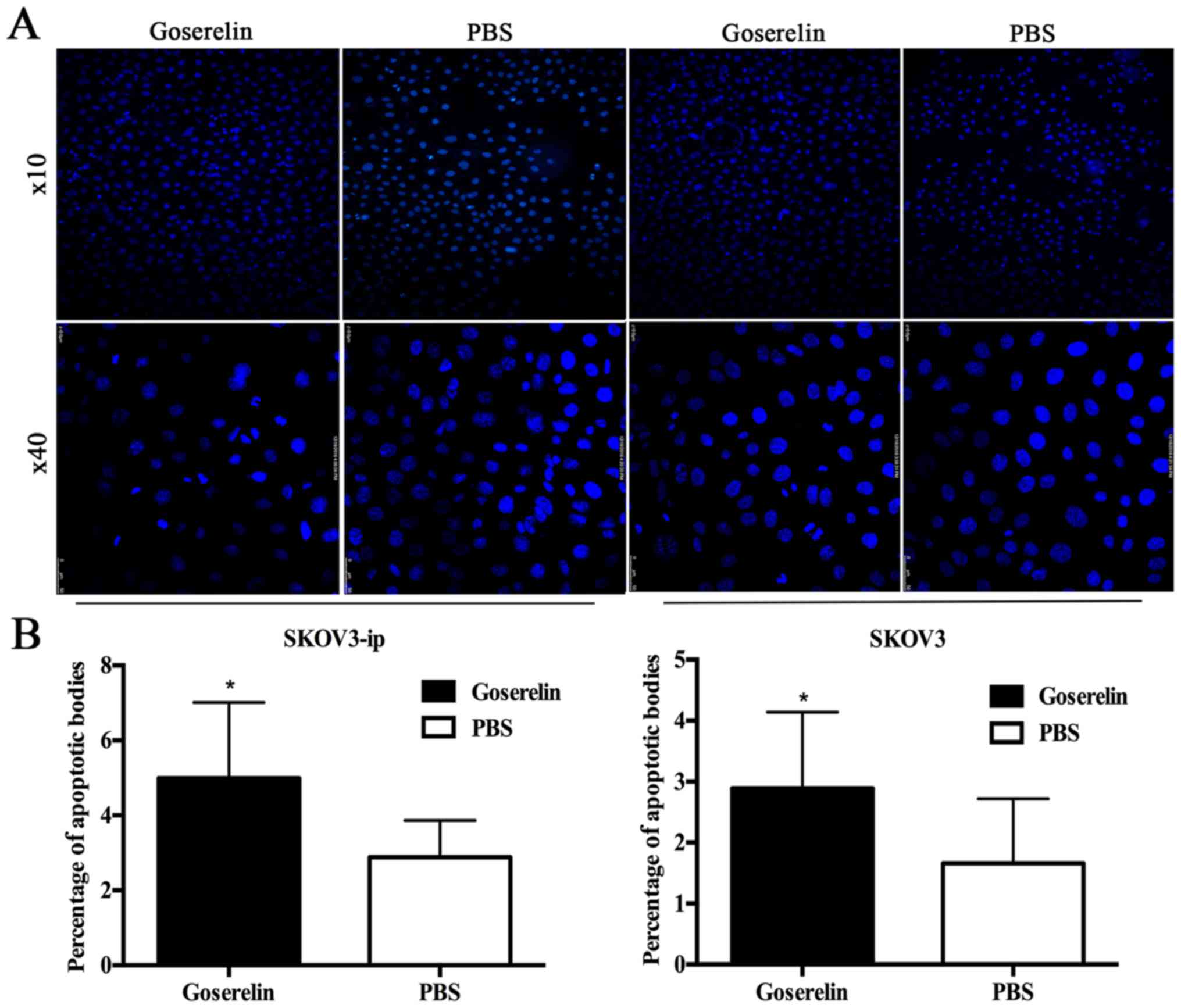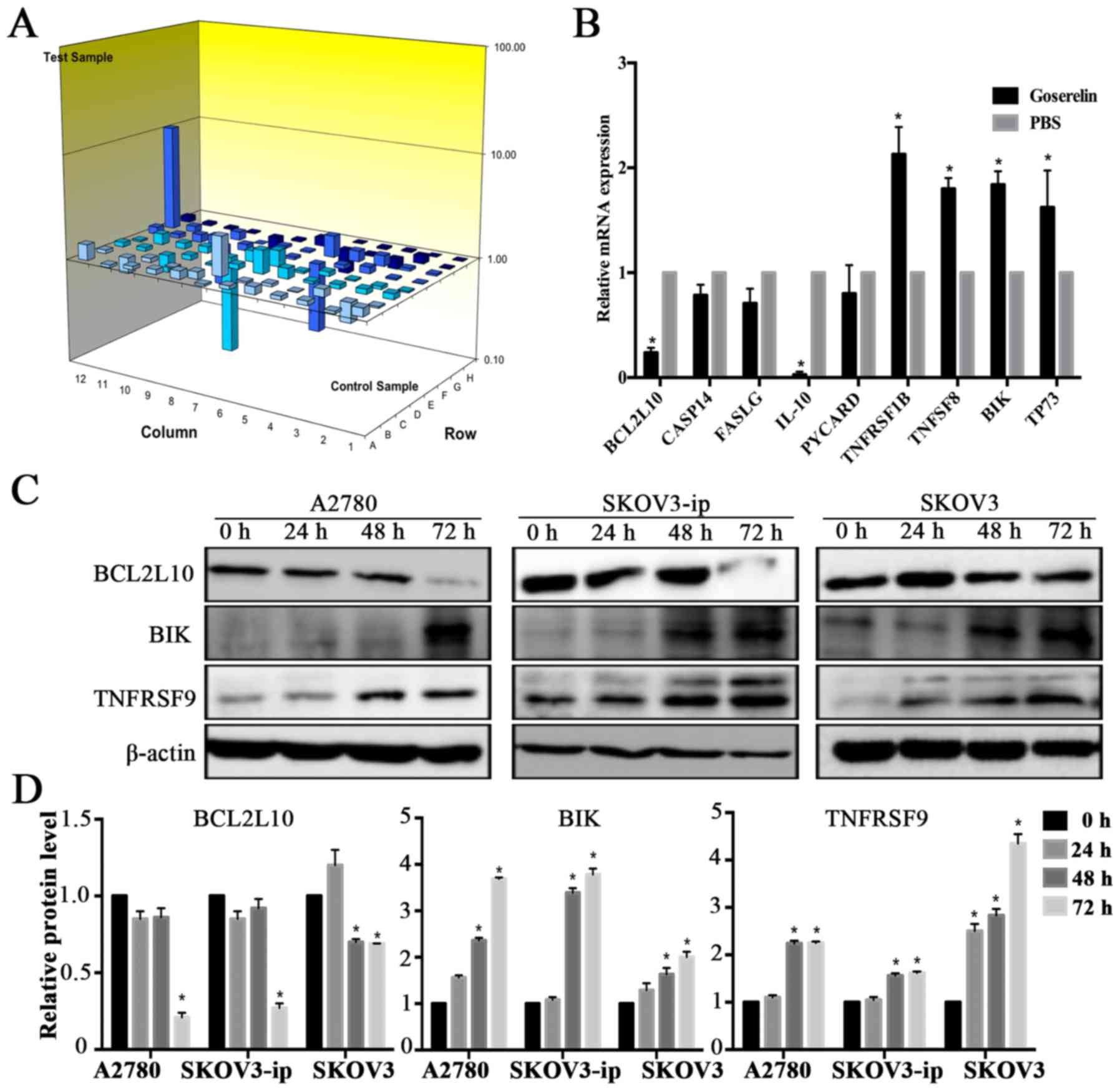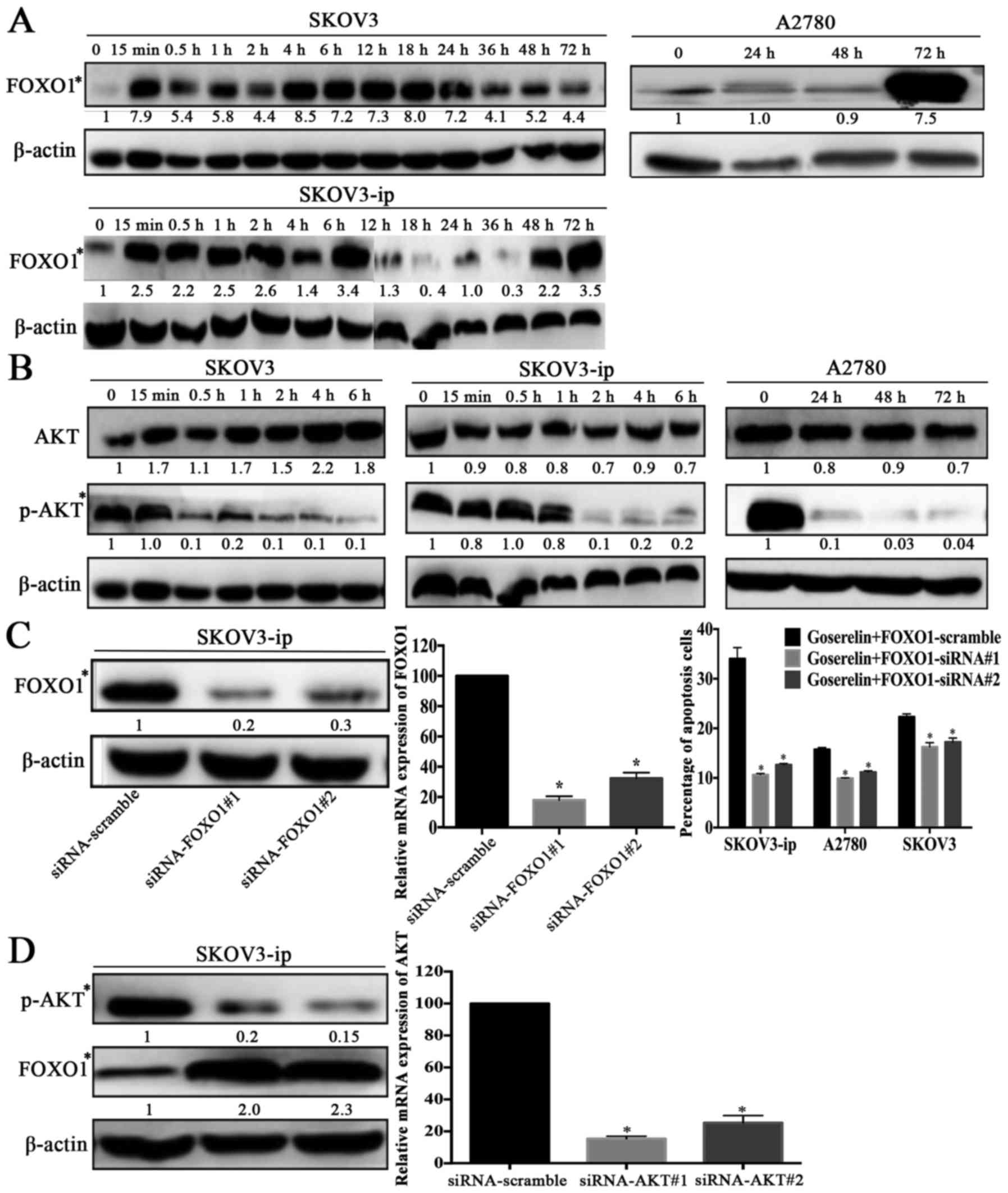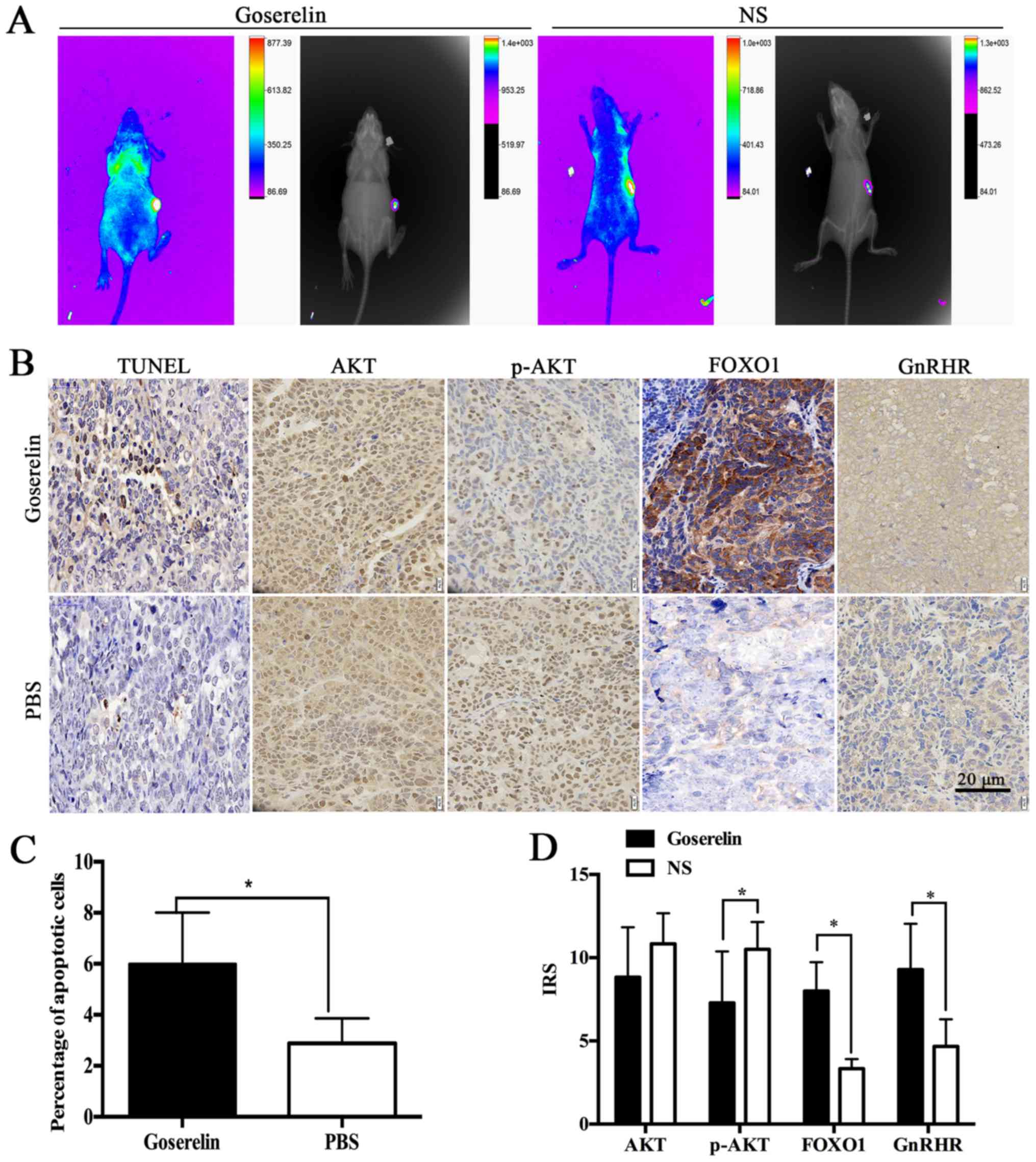Goserelin promotes the apoptosis of epithelial ovarian cancer cells by upregulating forkhead box O1 through the PI3K/AKT signaling pathway
- Authors:
- Published online on: December 15, 2017 https://doi.org/10.3892/or.2017.6159
- Pages: 1034-1042
-
Copyright: © Zhang et al. This is an open access article distributed under the terms of Creative Commons Attribution License.
Abstract
Introduction
Epithelial ovarian cancer (EOC) accounts for 90% of all ovarian cancer cases, and is one of the three most common gynecological malignancies (1). EOC has a poor prognosis and is the leading cause of death from gynecologic cancers. Although advanced surgical techniques and newly emerging targeted therapies have improved patient outcomes, the 5-year survival rate for EOC patients is still low, at approximately 30–40% (2,3). In addition, the precise molecular mechanisms underlying the biological behavior of EOC remain unclear. Several hypotheses have been proposed to explain the etiology of EOC, such as the incessant ovulation hypothesis (4), the gonadotropin theory (5) and the sex-steroid hormone hypothesis (6). Increasing basic and epidemiological evidence has shown that the enriched hormonal environment in the ovary can influence the development of EOC (7).
Gonadotropins, including luteinizing hormone (LH) and follicle stimulating hormone (FSH), are conducive to the growth of ovarian cancer based on the ‘gonadotropin theory’ (5) and are regulated by gonadotropin-releasing hormone (GnRH). GnRH agonists initially stimulate the release of gonadotropins, while sustained administration inhibits the release by desensitizing or downregulating the expression of the GnRH receptor (GnRHR). Clinically, GnRH agonists have been widely used in the treatment of hormone-dependent tumors, such as breast (8) and prostate cancer (9). GnRH and GnRH agonists are involved in the regulation of proliferation, apoptosis and other biological behaviors of ovarian cancer cells (10,11). Previous studies, including ours, have revealed that GnRH agonists inhibit the growth and proliferation of ovarian cancer through GnRHR (10,12–14), indicating that GnRH agonists and the GnRHR may be used as antitumor strategies in the future (15).
However, the effect of GnRH agonists on the apoptosis of EOC cells and their molecular mechanisms remain largely unidentified. In this study, we aimed to investigate the biological function of goserelin and the underlying mechanisms involving goserelin and EOC apoptosis using in vitro and in vivo experiments. The present study will facilitate a better understanding of the mechanisms underlying the effect of GnRH agonists on EOC. Meanwhile, key factors in the regulatory pathways may provide new therapeutic targets for the treatment of EOC.
Materials and methods
Cell lines and reagents
The human EOC cell lines (SKOV3, SKOV3-ip and A2780) were kindly provided by the University of Texas MD Anderson Cancer Center (Houston, TX, USA) and were authenticated by Short Tandem Repeat (STR) profiling. All cells were cultured in RPMI-1640 medium with 10% fetal bovine serum (FBS) (both from Gibco, Grand Island, NY, USA) and 100 U/ml penicillin, 100 mg/ml streptomycin at 5% CO2 in a 37°C humidified atmosphere. The GnRH agonist goserelin acetate was purchased from Sigma-Aldrich (St. Louis, MO, USA) and dissolved in phosphate-buffered solution (PBS, in vitro) or normal saline (NS, in vivo).
Goserelin stimulation
Monoplast suspensions of SKOV3, SKOV3-ip or A2780 cells were seeded into 6-well plates at a density of 2×105 cells/ml and a total volume of 2 ml. Twenty-four hours later, EOC cells were starved in FBS-free medium for 18 h. Then, the cells were stimulated with different concentrations (10−9, 10−8, 10−7, 10−6, 10−5, 10−4 or 10−3 mol/l) of goserelin (for the flow cytometry) or 10−4 mol/l goserelin (for apoptosis assay, human apoptosis gene PCR array, qRT-PCR and the relative protein assay) for different time courses. PBS was used as a control. The transfected cells were also starved for 18 h and then stimulated with 10−4 mol/l goserelin for another 48 h. The cells were harvested and used for flow cytometry; meanwhile the protein or mRNA were extracted for western blot or qRT-PCR analyses.
Apoptosis assay
Apoptotic cells were identified by Annexin V-PE Apoptosis Detection kit (BD Biosciences, Franklin Lakes, NJ, USA) or the Hoechst staining kit (Beyotime Institute of Biotechnology, Shanghai, China) according to the manufacturers instructions. EOC cells were starved in FBS-free medium for 18 h before treatment with goserelin or PBS. After incubating for the indicated periods of time, the cells were harvested and washed twice with cold PBS and resuspended in binding buffer at a concentration of 1×106 cell/ml. PE Annexin V (5 µl) and 7-AAD (5 µl) were added and then incubation was carried out for 15 min in the dark. A flow cytometer and FlowJo software (Flowjo LLC, Ashland, OR, USA) were used to analyze the staining data. Meanwhile, following the corresponding treatment, cells incubated in 6-well plates were stained with Hoechst staining at room temperature in the dark for 5 min and subsequently observed under confocal microscopy (Leica Microsystems, Wetzlar, Germany) with an excitation wavelength of 350 nm and an emission wavelength of 460 nm.
Western blotting
Cells were harvested in RIPA lysis buffer containing PMSF and phosphatase inhibitor (Sangon Biotech Co., Ltd., Shanghai, China) and the protein concentration was quantified using a BCA assay kit (Beyotime Institute of Biotechnology). Equal amounts of protein (40 µg/lane) were separated on SDS-PAGE gels and transferred to PVDF membranes. The membranes were blocked with 5% non-fat milk for 1 h and incubated with primary antibodies at 4°C overnight. After incubating with an HRP-conjugated secondary antibody, the bands were visualized using an ECL detection system (Thermo Fisher Scientific, Waltham, MA, USA). Antibodies including rabbit anti-cleaved-caspase-3 monoclonal antibody (cat. no. 9664, 1:1,000), rabbit anti-p-AKT (Ser473) monoclonal antibody (cat. no. 4060, 1:1,000), rabbit anti-AKT monoclonal antibody (cat. no. 4691, 1:1,000), rabbit anti-FOXO1 monoclonal antibody (cat. no. 2880, 1:1,000), rabbit anti-BIK polyclonal antibody (cat. no. 4592, 1:1,000) and rabbit anti-TNFRSF9 polyclonal antibody (cat. no. 62634, 1:1,000) were purchased from Cell Signaling Technology (Danvers, MA, USA). Rabbit anti-GnRHR polyclonal antibody (cat. no. ab183079, 1:1,000), rabbit anti-cleaved-PARP monoclonal antibody (cat. no. ab32064, 1:1,000) and rabbit anti-CIDEA polyclonal antibody (cat. no. ab151577, 1:1,000) were purchased from Abcam (Cambridge, UK).
siRNA and cell transfection
siRNAs were designed and purchased from Shanghai GenePharma Co., Ltd., Technology (Shanghai, China) and are listed in Table I. FOXO1-siRNA, AKT-siRNA and scrambled siRNA were transfected into cells using Lipofectamine 2000 (Invitrogen, Carlsbad, CA, USA) according to the manufacturers protocol. Briefly, 2×105 SKOV3-ip cells/well were seeded into 6-well plates for 24 h when the cells had reached 40–50% confluence. Before transfection, the RPMI-1640 medium without FBS and antibiotics were replaced. A total of siRNA (75 pmol) and 5 µl of Lipofectamine 2000 were diluted in 125 µl Opti-MEM and incubated for 5 min at room temperature, respectively. The diluted siRNA and diluted Lipofectamine 2000 were mixed gently and incubated for 20 min. A total of 250 µl mixed-combination was added to each well in a final volume of 2 ml/well.
Human apoptosis gene PCR array and qRT-PCR
SKOV3-ip cells were starved in FBS-free medium for 18 h before treatment with goserelin or PBS. After 48 h of incubation, total RNA was extracted using an RNeasy® Mini kit (Qiagen, Hilden, Germany) and then converted into cDNA using an RT2 First Strand kit (Qiagen) following the manufacturers instructions. Apoptosis-associated gene expression profiles were evaluated using RT2 Profiler™ PCR Arrays (Qiagen), which assess 84 genes involved in different apoptosis pathways. In addition, qRT-PCR was performed to confirm the differential expression of apoptosis-related genes using the ABI 7000 Real-Time PCR system (Applied Biosystems, Foster City, CA, USA) with an RT-PCR kit (Takara Bio, Shiga, Japan) according to the manufacturers protocol. The primers (Sangon Biotech) used in qRT-PCR are listed in Table II. The PCR conditions included an initial denaturation step at 95°C for 10 min and 45 cycles of 95°C for 5 sec and 60°C for 30 sec. All the experiments were performed in triplicate, and all the samples were normalized to β-actin expression. The expression fold changes were calculated using the 2−ΔΔCt method.
In vivo study
Five-week-old specific-pathogen free (SPF) female nude mice, weighing 18–20 g, were purchased from Shanghai SLAC Laboratory Animal Corporation. The mice were cared for in accordance with the criteria of the Medical Laboratory Animal Administrative Committee of Shanghai and the Guide for the Care and Use of Laboratory Animals. All experimental procedures were approved by the Ethics Committee of Obstetrics and Gynecology Hospital of Fudan University.
SKOV3 (1×107/ml) cells were heterotransplanted into 14 nude mice, 6 of which were injected with SKOV3 cells labelled with CM-DiI (Invitrogen). Six CM-DiI-labelled nude mice and the other 8 nude mice were divided randomly into 2 groups respectively: the Goserelin group was subcutaneously injected daily with 100 µg of goserelin in 200 µl of NS (14,16,17); the NS group was subcutaneously injected with 200 µl of NS per day. Subcutaneous xenograft tumors in nude mice were monitored by an in vivo imaging system. After 19 days of treatment, the mice were sacrificed, and the xenograft tumors were fixed in 4% paraformaldehyde for immunohistochemistry and TUNEL staining. The weights of the nude mice, TUNEL staining and immunohistochemical staining for FOXO1, AKT/p-AKT and GnRHR expression in the xenograft tumors were compared between the two groups.
CM-DiI for long-term cellular labeling
Stock solutions of CM-DiI were prepared in DMSO at 1 mg/ml. SKOV3 cells were harvested and washed twice with PBS and resuspended in PBS at a concentration of 1×106 cells/ml. An appropriate 1 mg/ml stock solution was added into the cell suspension at a 1 µg/ml final working concentration and incubated for 6 min at 37°C and then for an additional 15 min at 4°C. Labelled SKOV3 cells were washed twice with PBS again and resuspended in PBS at a concentration of 1×107 cells/ml. A drop of labelled SKOV3 cells was placed on a slide and the efficiency of cell labelling was determined to be 98% under a fluorescence microscope.
Immunohistochemistry (IHC) and TUNEL staining
The xenograft tumors were fixed in 4% paraformaldehyde and dehydrated through a serial alcohol gradient and then embedded in paraffin. After sectioning (5-µm thick), the tissues were immunostained with anti-FOXO1 (1:50), anti-AKT (1:200), anti-p-AKT (1:50) and anti-GnRHR (1:300) antibodies using a Histostain-Plus IHC kit (NeoBioscience, Shanghai, China) and subjected to TUNEL staining using a TUNEL Apoptosis Assay kit (Roche Diagnostics, Indianapolis, IN, USA) following the manufacturers protocol. The immunostaining was evaluated by determining the immunoreactive score (IRS). The IRS was calculated by multiplying the staining intensity (SI) by the percentage of positive cells (PP). SI was defined as 0 (negative), 1 (weak), 2 (moderate) and 3 (strong). PP was defined as 0 (negative), 1 (≤10% positive cells), 2 (11–50% positive cells), 3 (51–75% positive cells) and 4 (>75% positive cells). IRS = SI × PP, and an IRS >3 was defined as positive (18).
Statistical analysis
Stata 14.0 (StataCorp LP, College Station, TX, USA) and GraphPad Prism 6.0 (GraphPad Software Inc., La Jolla, CA, USA) were used for the statistical analyses. Continuous data are expressed as the mean ± SD, and analyzed by independent t-test between two groups or one-way ANOVA among multiple groups. The categorical data were compared using the Chi-squared or Fishers exact tests as appropriate. Differences were considered statistically significant at P<0.05.
Results
Goserelin promotes the apoptosis of EOC cells in vitro
SKOV3, SKOV3-ip and A2780 cells all expressed GnRHR (Fig. 1A). Apoptosis detected by flow cytometry showed that different concentrations of goserelin increased the proportion of apoptotic SKOV3-ip cells compared with the control group at 48 and 72 h (P<0.05; Fig. 1B and C). A concentration of 10−4 mol/l goserelin significantly increased the total apoptosis rate of SKOV3-ip, SKOV3 and A2780 cells (P<0.05; Fig. 2A and B). To further clarify the effect of goserelin on apoptosis, we treated the cells with 10−4 mol/l goserelin for 24, 48 and 72 h. Hoechst staining showed that the number of apoptotic bodies was significantly increased in the SKOV3 and SKOV3-ip cells compared with the control group (P<0.05; Fig. 3). Furthermore, the expression of cleaved-caspase-3 and cleaved-PARP were observably increased after treatment with 10−4 mol/l goserelin (P<0.05; Fig. 4). Taken together, these results suggested that goserelin promoted EOC cell apoptosis.
Expression of human apoptosis-related genes is regulated by goserelin in SKOV3-ip cells
To investigate the downstream molecular process involving goserelin and EOC apoptosis, human apoptosis gene PCR arrays were tested in the SKOV3-ip-PBS and SKOV3-ip-Goserelin group. According to the apoptosis gene PCR array, 9 genes were obviously expressed (fold change ≥1.5) in the SKOV3-ip-Goserelin group compared with the SKOV3-ip-PBS group (Table III). qRT-PCR and western blot analyses were performed to confirm the expression of these genes, including members of the tumor necrosis factor (TNF) and TNF receptor superfamilies (such as TNFRSF9, TNFRSF1B and TNFSF8). The results were mostly consistent with those of the PCR array analysis (Fig. 5A-D).
Table III.Nine differentially expressed genes (fold change ≥1.5) were screened in the SKOV3-ip-Goserelin group. |
Goserelin influences EOC cell apoptosis by upregulating FOXO1 through the PI3K/AKT signaling pathway
TNF and TNF receptors are reportedly regulated by FOXO1 (19). We then detected the expression of FOXO1 by goserelin at 10−4 mol/l. As shown in Fig. 6A, FOXO1 expression was significantly increased (P<0.05) and the goserelin-mediated promotion of apoptosis was abrogated by FOXO1-siRNA (P<0.05; Fig. 6C).
As FOXO1 is a downstream target of the PI3K/AKT signaling pathway (20,21), the expression of AKT/p-AKT was analyzed. As shown in Fig. 6B, goserelin downregulated p-AKT (Ser473) expression. Meanwhile, the expression of FOXO1 was increased by AKT-siRNA (P<0.05; Fig. 6D). Taken together, these data suggest that goserelin may promote EOC cell apoptosis by upregulating FOXO1 through the PI3K/AKT signaling pathway.
Effect of goserelin on subcutaneous xenograft tumors in nude mice
In vivo images of subcutaneous xenograft tumors in nude mice revealed that the subcutaneous xenograft tumor model was constructed successfully (Fig. 7A). TUNEL staining showed that goserelin significantly increased the proportion of apoptotic cells in the subcutaneous xenograft tumors (P<0.05; Fig. 7B and C). Immunohistochemistry results showed that the difference in AKT expression between the two groups was not significant. In the goserelin group, p-AKT expression was significantly lower, while the expression of FOXO1 and GnRHR were significantly increased compared with the NS group (P<0.05; Fig. 7B and D). Therefore, the expression of the key factors in the PI3K/AKT-FOXO1 pathway was consistent with that observed in vitro.
Discussion
According to the gonadotropin theory (5), gonadotropins, including LH and FSH, are conducive to the growth of ovarian cancer, which can be downregulated by GnRH agonists. Theoretically, GnRH agonists inhibit the growth and proliferation of ovarian cancer. Several studies, including ours, have revealed that GnRH agonists can directly inhibit the growth and proliferation of various human cancer cell lines, including ovarian cancer cell lines, through the GnRHR in a dose- and time-dependent manner (8–10,12–14). In the present study, we demonstrated that SKOV3, SKOV3-ip and A2780 cells all expressed GnRHR, which may be required for goserelin to act on these three cell lines. We found that goserelin promoted EOC cell apoptosis, which was verified by different methods in three EOC cell lines. In vivo, goserelin also promoted the apoptosis of xenograft tumors. Considering its less adverse side-effects compared with chemotherapeutic drugs, goserelin may be a safe and effective antitumor strategy in the future.
It has been reported that the apoptosis of human ovarian cancer cells may be regulated by goserelin (13,22). We used human apoptosis gene PCR array to explore the downstream molecular events involving goserelin and EOC apoptosis. Goserelin regulated several apoptosis-related factors, especially members of the TNF and TNF receptor superfamilies, which are regulated by FOXO1 (19). The FOXO transcription factors are considered to be tumor suppressors that inhibit cell proliferation and induce apoptosis (21). Indeed, FOXO1 plays multiple roles in various types of human cancers, including skin (23), liver (24) and breast cancer (25). An increasing number of studies have linked the tumor suppressor activity of FOXOs to the regulation of genes involved in cell death (e.g., Fasl) (26) and cell cycle arrest (e.g., p27KIP1) (27). In agreement with these reports, we found that goserelin increased FOXO1 expression. Meanwhile, the pro-apoptotic effect of goserelin was abrogated by FOXO1-siRNA. These results indicate that goserelin induces EOC cell apoptosis by modulating FOXO1 activity.
It has been reported that AKT phosphorylation following growth factor stimulation can lead to FOXO inactivation (28). In breast cancer cell lines, the targeted depletion of PI3K using siRNA reactivates FOXO1, 3 and 4, which then induces cell cycle arrest and apoptosis (29). The same anti-proliferation and pro-apoptotic effects were observed when FOXO1 was reactivated in cervical cancer treated with the PI3K inhibitor LY294002 (30). We hypothesized that goserelin may promote EOC cell apoptosis by upregulating FOXO1 through the PI3K/AKT signaling pathway. As expected, goserelin down-regulated p-AKT expression, and FOXO1 upregulation was dependent on PI3K/AKT. The mechanism by which goserelin activates the AKT signaling pathway requires further exploration. In vivo, the expression of key factors in the PI3K/AKT-FOXO1 pathway was consistent with that observed in vitro. Importantly, GnRHR expression in the goserelin group increased significantly, indicating that goserelin may exert its biological effects through the GnRHR.
In summary, our results demonstrated the pro-apoptotic effects of goserelin on EOC cells and showed for the first time that goserelin may promote EOC cell apoptosis by upregulating FOXO1 through the PI3K/AKT signaling pathway. PI3K/AKT-FOXO1 pathway may be the novel therapeutic target for the treatment of EOC. GnRH agonists may also be potential antitumor agents.
Acknowledgements
The present study was supported by the Youth National Natural Science Foundation of China (NSFC no. 81402152).
References
|
Hemminki K, Sundquist J and Brandt A: Incidence and mortality in epithelial ovarian cancer by family history of any cancer. Cancer. 117:3972–3980. 2011. View Article : Google Scholar : PubMed/NCBI | |
|
Rustin G, van der Burg M, Griffin C, Qian W and Swart AM: Early versus delayed treatment of relapsed ovarian cancer. Lancet. 377:380–381. 2011. View Article : Google Scholar : PubMed/NCBI | |
|
Chen W, Zheng R, Baade PD, Zhang S, Zeng H, Bray F, Jemal A, Yu XQ and He J: Cancer statistics in China, 2015. CA Cancer J Clin. 66:115–132. 2016. View Article : Google Scholar : PubMed/NCBI | |
|
Casagrande JT, Louie EW, Pike MC, Roy S, Ross RK and Henderson BE: ‘Incessant ovulation’ and ovarian cancer. Lancet. 2:170–173. 1979. View Article : Google Scholar : PubMed/NCBI | |
|
Millar RP: GnRHs and GnRH receptors. Anim Reprod Sci. 88:5–28. 2005. View Article : Google Scholar : PubMed/NCBI | |
|
Leung PC and Choi JH: Endocrine signaling in ovarian surface epithelium and cancer. Hum Reprod Update. 13:143–162. 2007. View Article : Google Scholar : PubMed/NCBI | |
|
Brekelmans CT: Risk factors and risk reduction of breast and ovarian cancer. Curr Opin Obstet Gynecol. 15:63–68. 2003. View Article : Google Scholar : PubMed/NCBI | |
|
Kim HJ, Yoon TI, Chae HD, Kim JE, Chae EY, Yu JH, Sohn G, Ko BS, Lee JW, Son BH, et al: Concurrent gonadotropin-releasing hormone agonist administration with chemotherapy improves neoadjuvant chemotherapy responses in young premenopausal breast cancer patients. J Breast Cancer. 18:365–370. 2015. View Article : Google Scholar : PubMed/NCBI | |
|
Hoda MR, Kramer MW, Merseburger AS and Cronauer MV: Androgen deprivation therapy with Leuprolide acetate for treatment of advanced prostate cancer. Expert Opin Pharmacother. 18:105–113. 2017. View Article : Google Scholar : PubMed/NCBI | |
|
Zhang Z, Jia L, Feng Y and Zheng W: Overexpression of follicle-stimulating hormone receptor facilitates the development of ovarian epithelial cancer. Cancer Lett. 278:56–64. 2009. View Article : Google Scholar : PubMed/NCBI | |
|
Zhang Z, Liao H, Chen X, Zheng Y, Liu Y, Tao X, Gu C, Dong L, Duan T, Yang Y, et al: Luteinizing hormone upregulates survivin and inhibits apoptosis in ovarian epithelial tumors. Eur J Obstet Gynecol Reprod Biol. 155:69–74. 2011. View Article : Google Scholar : PubMed/NCBI | |
|
So WK, Cheng JC, Poon SL and Leung PC: Gonadotropin-releasing hormone and ovarian cancer: A functional and mechanistic overview. FEBS J. 275:5496–5511. 2008. View Article : Google Scholar : PubMed/NCBI | |
|
Meyer C, Sims AH, Morgan K, Harrison B, Muir M, Bai J, Faratian D, Millar RP and Langdon SP: Transcript and protein profiling identifies signaling, growth arrest, apoptosis, and NF-κB survival signatures following GNRH receptor activation. Endocr Relat Cancer. 20:123–136. 2013. View Article : Google Scholar : PubMed/NCBI | |
|
Zhang Y, Ding JX, Tao X, Lu ZY, Wang JJ, Feng WW and Hua KQ: Goserelin can inhibit ovarian cancer proliferation and simultaneously protect ovarian function from cisplatin: An in vitro and in vivo study. J Chemother. 25:96–103. 2013. View Article : Google Scholar : PubMed/NCBI | |
|
Aguilar-Rojas A, Pérez-Solis MA and Maya-Núñez G: The gonadotropin-releasing hormone system: Perspectives from reproduction to cancer (Review). Int J Oncol. 48:861–868. 2016. View Article : Google Scholar : PubMed/NCBI | |
|
Yano T, Pinski J, Halmos G, Szepeshazi K, Groot K and Schally AV: Inhibition of growth of OV-1063 human epithelial ovarian cancer xenografts in nude mice by treatment with luteinizing hormone-releasing hormone antagonist SB-75. Proc Natl Acad Sci USA. 91:pp. 7090–7094. 1994; View Article : Google Scholar : PubMed/NCBI | |
|
Dondi D, Moretti RM, Montagnani Marelli M, Pratesi G, Polizzi D, Milani M, Motta M and Limonta P: Growth-inhibitory effects of luteinizing hormone-releasing hormone (LHRH) agonists on xenografts of the DU 145 human androgen-independent prostate cancer cell line in nude mice. Int J Cancer. 76:506–511. 1998. View Article : Google Scholar : PubMed/NCBI | |
|
Friedrichs K, Gluba S, Eidtmann H and Jonat W: Overexpression of p53 and prognosis in breast cancer. Cancer. 72:3641–3647. 1993. View Article : Google Scholar : PubMed/NCBI | |
|
van der Vos KE and Coffer PJ: The extending network of FOXO transcriptional target genes. Antioxid Redox Signal. 14:579–592. 2011. View Article : Google Scholar : PubMed/NCBI | |
|
Cardozo T and Pagano M: The SCF ubiquitin ligase: Insights into a molecular machine. Nat Rev Mol Cell Biol. 5:739–751. 2004. View Article : Google Scholar : PubMed/NCBI | |
|
Coomans de Brachène A and Demoulin JB: FOXO transcription factors in cancer development and therapy. Cell Mol Life Sci. 73:1159–1172. 2016. View Article : Google Scholar : PubMed/NCBI | |
|
Gründker C, Schulz K, Günthert AR and Emons G: Luteinizing hormone-releasing hormone induces nuclear factor kappaB-activation and inhibits apoptosis in ovarian cancer cells. J Clin Endocrinol Metab. 85:3815–3820. 2000. View Article : Google Scholar : PubMed/NCBI | |
|
Tsitsipatis D, Klotz LO and Steinbrenner H: Multifaceted functions of the forkhead box transcription factors FoxO1 and FoxO3 in skin. Biochim Biophys Acta. 1861:1057–1064. 2017. View Article : Google Scholar : PubMed/NCBI | |
|
Carbajo-Pescador S, Mauriz JL, García-Palomo A and González-Gallego J: FoxO proteins: Regulation and molecular targets in liver cancer. Curr Med Chem. 21:1231–1246. 2014. View Article : Google Scholar : PubMed/NCBI | |
|
Procaccia S, Ordan M, Cohen I, Bendetz-Nezer S and Seger R: Direct binding of MEK1 and MEK2 to AKT induces Foxo1 phosphorylation, cellular migration and metastasis. Sci Rep. 7:430782017. View Article : Google Scholar : PubMed/NCBI | |
|
Fu Z and Tindall DJ: FOXOs, cancer and regulation of apoptosis. Oncogene. 27:2312–2319. 2008. View Article : Google Scholar : PubMed/NCBI | |
|
Ho KK, Myatt SS and Lam EW: Many forks in the path: Cycling with FoxO. Oncogene. 27:2300–2311. 2008. View Article : Google Scholar : PubMed/NCBI | |
|
Brunet A, Bonni A, Zigmond MJ, Lin MZ, Juo P, Hu LS, Anderson MJ, Arden KC, Blenis J and Greenberg ME: Akt promotes cell survival by phosphorylating and inhibiting a Forkhead transcription factor. Cell. 96:857–868. 1999. View Article : Google Scholar : PubMed/NCBI | |
|
Reagan-Shaw S and Ahmad N: RNA interference-mediated depletion of phosphoinositide 3-kinase activates forkhead box class O transcription factors and induces cell cycle arrest and apoptosis in breast carcinoma cells. Cancer Res. 66:1062–1069. 2006. View Article : Google Scholar : PubMed/NCBI | |
|
Prasad SB, Yadav SS, Das M, Govardhan HB, Pandey LK, Singh S, Pradhan S and Narayan G: Down regulation of FOXO1 promotes cell proliferation in cervical cancer. J Cancer. 5:655–662. 2014. View Article : Google Scholar : PubMed/NCBI |



